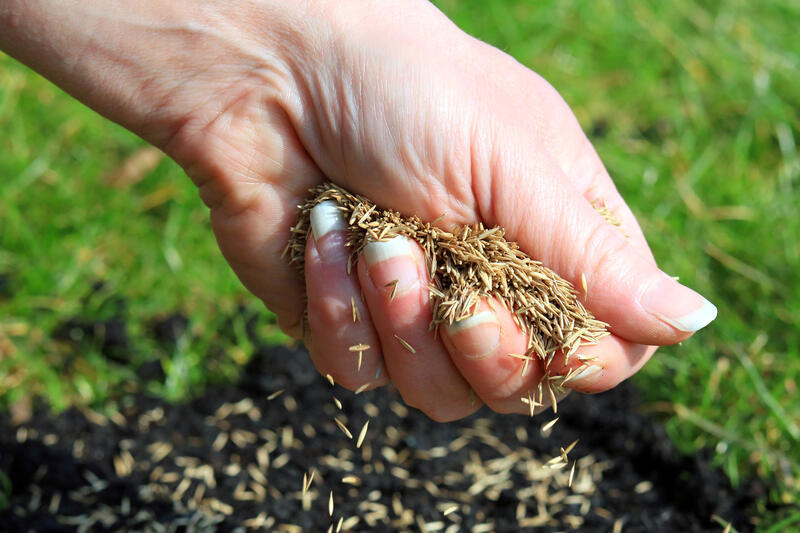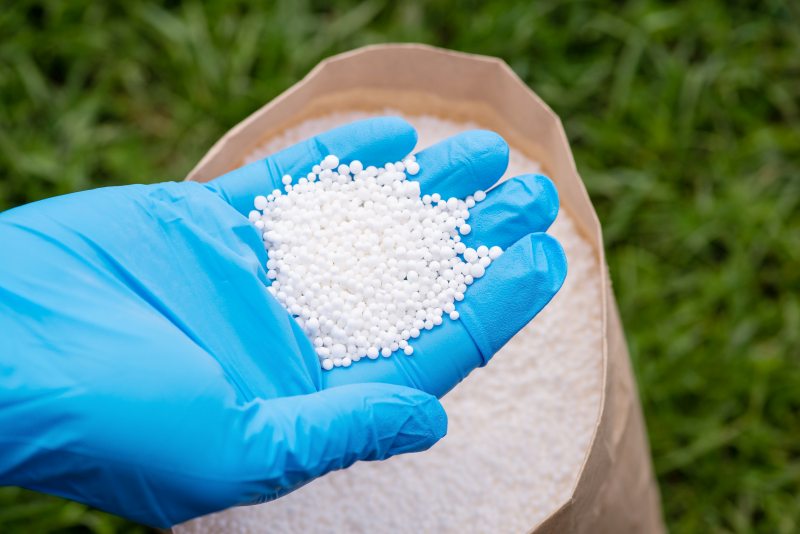
While lawn care is a constant work-in-progress, there are some steps you can take this spring to ensure you have a gorgeous lawn through the seasons. Our lawn care tips for Little Rock will help you to know what to do and when to help your lawn during this growing period.
From fertilizing at the right time to testing your soil and overseeding thin areas, taking the right steps now will set your lawn up for success.
1. Overseed to Fill in Thin Areas

Overseeding is the process of spreading grass seed over an existing lawn to thicken turf, improve its appearance, and fill in bare patches. It’s especially useful for repairing winter damage and helping your lawn grow stronger before the summer heat arrives.
The best time to overseed depends on your grass type, according to the University of Arkansas Extension:
- Bermudagrass: Overseed between March and May for optimal growth.
- Zoysia: Wait until May or June.
- Centipedegrass: Like Zoysia, it grows best when overseeded in summer, preferably June.
- Tall fescue: The ideal time is fall, but spring overseeding can be done from February to April.
See Related:
— Best Grass Types for Lawns in Little Rock
— When to Overseed in Spring
— How to Overseed a Lawn in 8 Simple Steps
— When to Mow After Overseeding
2. Test Your Soil Before Fertilizing

A soil test helps you understand exactly what nutrients your grass needs. Instead of guessing and applying unnecessary fertilizers, a soil test provides accurate results on your lawn’s pH levels, nutrient deficiencies, and overall soil health.
Spring is an excellent time to try a soil test for the first time. Even if you have conducted a soil test in the past, soil composition and nutrient content can change, so it’s important to do this semi-regularly.
See Related:
— Why, When, and How to Test the Soil pH of Your Lawn
— How to Use a Soil Test Kit on the Lawn
— Reasons Why Soil Testing Is Important for the Lawn
3. Fertilize at the Right Time

Fertilizing at the right time is essential for strong root development and healthy grass growth. The best fertilization schedule depends on whether you have warm-season or cool-season grass in your Little Rock lawn.
- Warm-season grasses: Fertilization begins in late spring to summer, once the grass is growing. The ideal fertilization window is May through August, but early September is also an option.
- Cool-season grasses: Fertilize from March to May, with April being the best month for spring feeding. Apply additional fertilizer in September and November to strengthen roots before winter.
See Related:
— When and How to Fertilize Your Arkansas Lawn
— How to Fix an Over-Fertilized Lawn
4. Don’t Worry About Irrigation
In Little Rock, spring rainfall usually provides enough moisture for established lawns, so frequent watering isn’t needed. However, if you’re planting new grass seed or sod, or if the weather turns hot, dry, or windy, you may need to supplement with additional watering.
If you notice these signs your lawn needs watering, it’s time to give it a good soak:
- Yellow patches of grass starting to dry out.
- Soil crumbling easily in your hand.
- Wilting grass blades that lose their vibrant green color.
- Lingering footprints that remain visible when you walk across the lawn.
See Related:
— How Often Should I Water My Lawn?
— How Much Water Does Zoysiagrass Need?
— How Much Water Does Centipedegrass Need?
5. Mow at the Right Height and Time

Proper mowing can make a big difference in how quickly your grass greens up. The best approach depends on your grass type.
- Bermuda and Zoysiagrass: Before these warm-season grasses start actively growing, mow them slightly shorter than usual to remove dead leaf blades. This allows more sunlight to reach emerging shoots and helps warm the soil faster. However, be careful not to scalp the lawn.
- Centipedegrass, St. Augustine, and Tall Fescue: Wait until these grasses start growing again before mowing. Once active growth begins, follow the one-third rule, meaning never remove more than one-third of the grass blade to prevent stress.
See Related:
— Bermudagrass Guide: Types, Traits, and Care
— Growing Zoysiagrass: Everything You Need to Know
— Centipedegrass Lawn Maintenance Guide
— How to Care for St. Augustinegrass
— Tall Fescue Lawn Maintenance Guide
6. Stay Ahead of Weeds
Spring is prime time for weed prevention. A pre-emergent herbicide can be applied in early spring, preferably in late February or early March, to prevent any stubborn summer weeds
If weeds start to appear later in the season, dig them out, making sure to remove the entire root, or spray them with a broadleaf weed killer. The key here is killing weeds before they seed into a new, booming population.
See Related:
— Complete Guide to Weed Control in Arkansas
— Best Pre-Emergent Herbicides for Lawns
— How to Apply Post-Emergent Herbicides to Your Lawn
— Best Post-Emergent Herbicides
7. Aerate Your Lawn (if Necessary)

Core aeration is the process of removing small plugs of soil from your lawn to reduce compaction and improve air, water, and nutrient flow to the roots. Aeration is needed only if your soil has compacted due to excess traffic, poor soil quality, or other related factors.
If you decide to aerate, wait until April for tall fescue and May for warm-season grasses; this will give you the best chance of growing grass afterward.
See Related:
— How to Aerate Your Lawn in Arkansas
— When and How Often Should You Aerate Your Lawn?
Set Up Your Little Rock Lawn for Success
Unlike other areas of the country, where spring lawn care is all about waking up your lawn after a long dormant period during the winter, spring lawn care in Little Rock is about prevention. Preparing your lawn for the hot summers ahead is crucial, so do so carefully to help your lawn weather whatever the hot months ahead throw in its direction.
Need expert help? Visit our Little Rock Lawn Care page and let one of LawnStarter’s local lawn care pros keep your lawn in top shape all year long. We also have lawn care pros in other Arkansas cities, like Fayetteville and Springdale.
Read More:
— Fall Lawn Care Tips for Little Rock Homeowners
— Planting Zones in Arkansas
— Best Grass Seed for Arkansas
Main Image Credit: Photo of a lawn mowed by a LawnStarter Pro in Little Rock, Arkansas